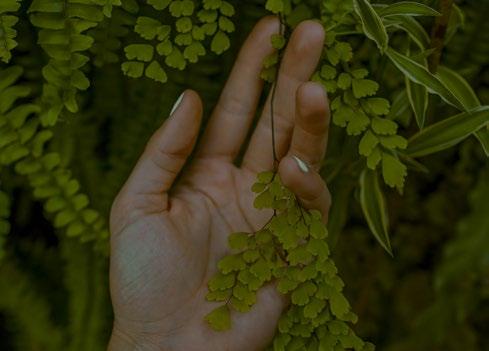
36 minute read
Healing Properties of Nature
Healing Properties of the World Around Us
Richard Jeneway offers some simple suggestions for using nature to improve mental and physical health
Advertisement
) Yesterday, while walking my dogs along the undercliff at Rottingdean, I took a moment to enjoy a glimpse of wintry sunshine, feeling its warmth on my face while inhaling the saltladen air. At the same time I was regaled by the plaintive call of a curlew wading in the rockpools – a sound seasonably linked in my mind to winter, but in the knowledge that spring is on its way. As a blind person my life is auditory, heightening my other senses and making me reliant on sound and smellscapes to understand my surroundings. Before I lost my sight, vision often dominated my other senses. “Making the most of what is here – whether park, beach or Downs – is paramount to our wellbeing”
We are fortunate here in Brighton to have both coastline and a city surrounded by downland forming part of the South Downs National Park. At the time of writing, I am going to stress that we will be limited by travel restrictions for more time to come. So, making the most of what is here – whether park, beach or Downs – is paramount to our wellbeing. It’s worth stopping now and then, whether you’re out for a run or just an amble around your neighbourhood, and taking time to be in the moment. Following an extraordinary winter of lockdown, social isolation and much more, I’ve been keeping in contact with a wide range of people of all ages, some of whom experienced depression for the first time and others a paranoia of becoming infected with Covid. For many emerging from winter alongside Covid feelings of depression remain, but hopefully with the roll out of vaccinations this will get easier. However for some this won’t happen overnight. I am acutely aware from speaking to a wide range of people in our community that many have a negative outlook, so accessing support from friends and other sources is very important for mental health and wellbeing. Sometimes getting out of our home environment can be achieved with a little encouragement to enjoy the beauty of springtime and putting the dark days of winter behind us. From childhood the spring has always filled me with a sense of excitement and renewal. The swelling buds of hawthorn, the sticky buds of horse chestnuts, the fluffy down of pussy willow, the early wild flowers and the heady fragrance of new season’s grasses along with the lengthening days. Bird song changes from the wintry sound of the territorial robins and gulls to the sound of chattering finches, sparrows and the gentle hum of bees brings a sense of joy. One of the few benefits of the current situation is that many have discovered what is local and on their doorstep. “As a blind person my life is auditory, heightening my other senses and making me reliant on sound and smellscapes to understand my surroundings”
Yoga and meditation are part of my own routine. With the warmer and longer days ahead, maybe find a place in a local park or within your local area and take time to sit under a tree and clear your mind of chatter and random thoughts. Learning to meditate has heightened my sense of self but, more importantly, my surroundings. The learnt ability to focus with a clear mind is a result of some very simple steps in meditation. I’ve asked a dear friend to make a contribution to this piece, enjoy reading and try the practice. Freeing the mind
Vajrasati yoga teacher Alistair McCall outlines the benefits of meditation along with some basic steps for the practice
Meditation can be defined as concentration. Not the sort of concentration you might apply to solving a problem, but rather a light, bright attention to your inner state. There are many benefits from meditating regularly. Stated conservatively, you will experience an increased sense of peace and wellbeing. If you continue in your practice you may notice that your daily life begins to feel richer and more vivid.
Happily, you don’t have to fold yourself into a pretzel shape to practise meditation. The actual practice is very simple. In the Satipatthana sutra, the Buddha’s advice is straightforward: Find a tree (or quiet space), sit with the body upright, and observe the breath. Try it. Find a time when you have 15 minutes to yourself. Sit comfortably with eyes gently closed and the spine straight – a hardback chair is fine – breathe freely and watch what arises within your mind and body. It could be a thought, a feeling, a sensation, or something else entirely. Most people’s minds struggle to accept that anything that offers a great benefit can also be this easily achieved. For this reason, people often worry that they ‘aren’t doing it right’. That’s where trust comes in. Trust whatever it is you are noticing, keep your attention on it and see what it does. There’s no need to describe the feeling to yourself or create an inner commentary on it. Just let it be what it is. Give it total acceptance. And, when the next thing pops into your head, do the same with that. You might notice in time that the space in-between things ‘coming up’ increases. At some other point, your mind will probably stray. Mine does. This is normal and fine. Bring your attention back to the breath. Don’t worry about it. It is only by redeploying the energy we lose to the various distractions of everyday life that we get to focus on our true selves for a while.
I sometimes speak to people who have the impression that their meditation has been unsuccessful unless it is a profound spiritual experience. The truth is that, for many people, most of the time, meditation is not like that at all. This is because when we meditate, we move beyond what we sometimes refer to these days as the ego, which is essentially a collection of stories we have constructed about ourselves. It is this ego that is gratified when we feel a sense of achievement.
Surprisingly, it is this break from the need to achieve or ‘be something’ that, for many people, can be the most compelling aspect of meditation. Meditation is unconditional love applied to every aspect of our being. No wonder it does us so much good.
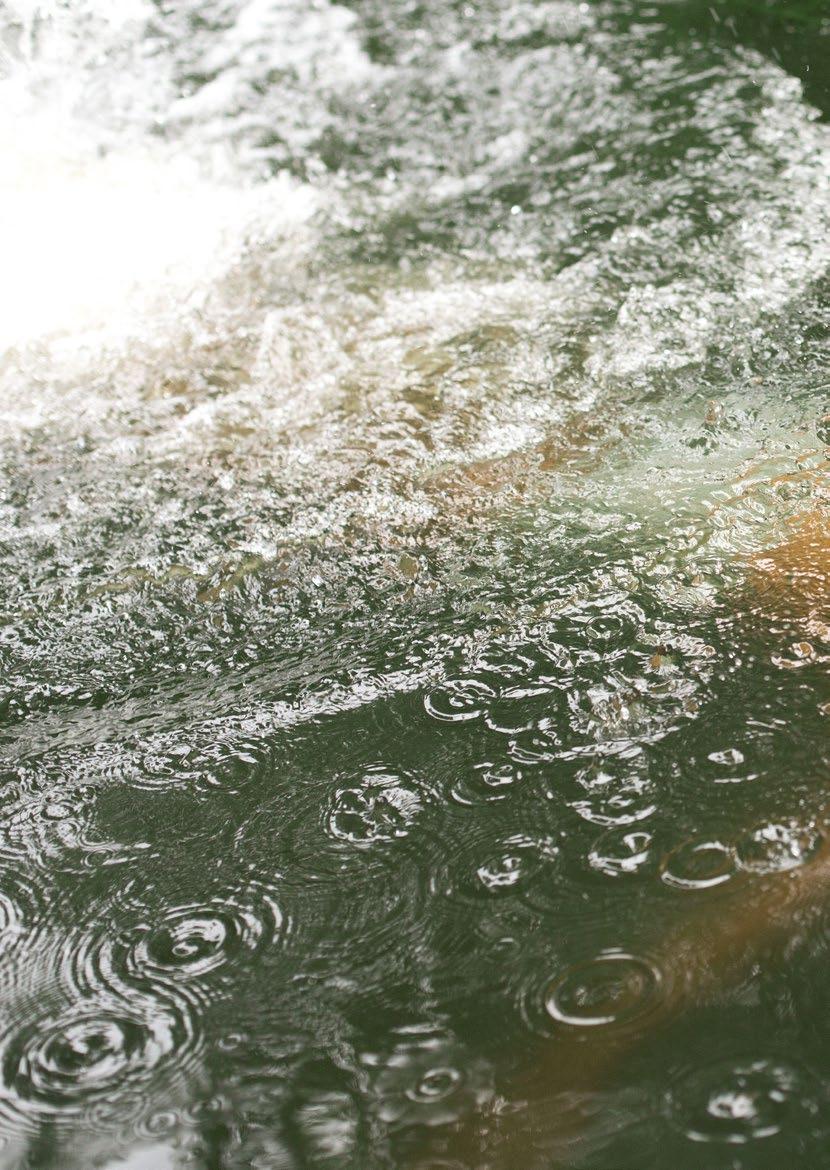
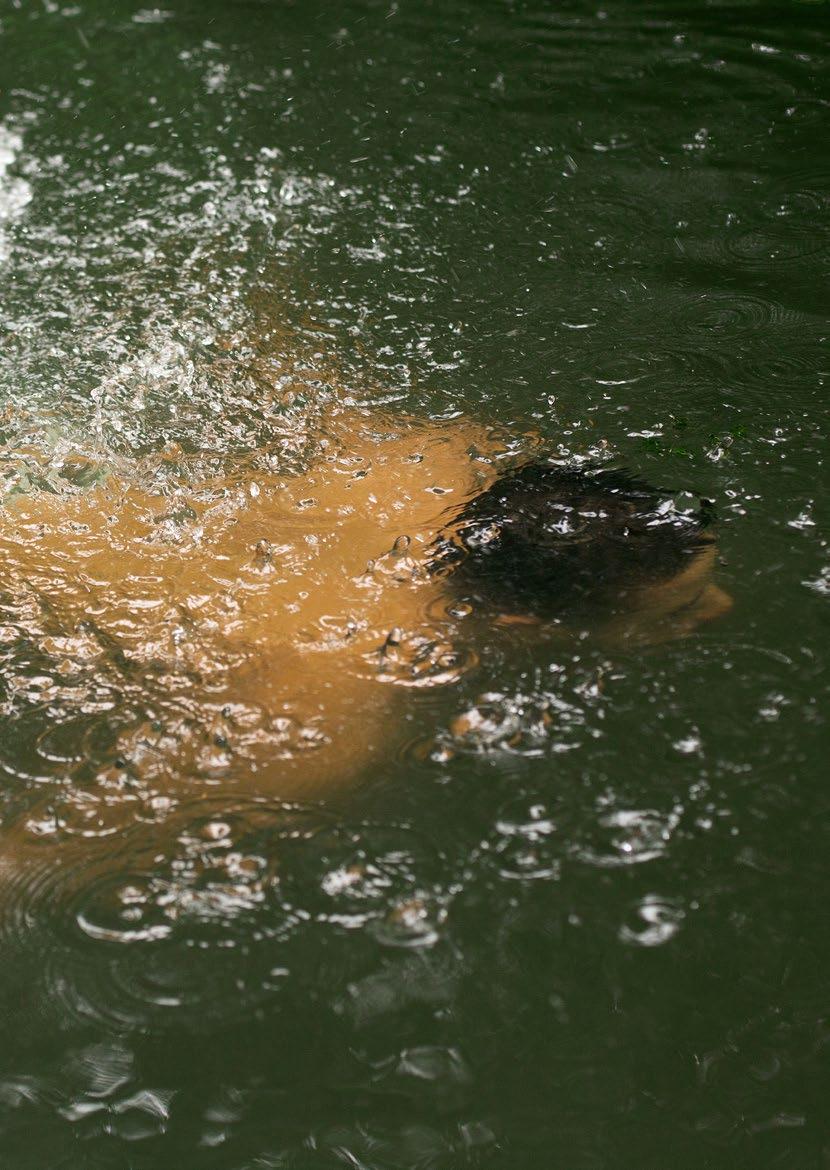
WWW.TEMSELMON.COM
DAVE LYNN. PHOTO BY TOM SELMON
DAVE LYNN - A LIVING LEGEND
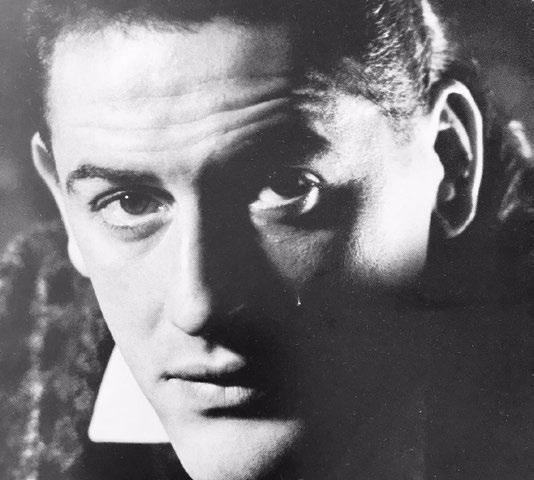
Jason Reid catches up with the iconic Dave Lynn, who has just celebrated 45 years of treading the boards
) Born and raised in Hackney, London, Dave Lynn is a living drag legend. Pure and simple. An artist that has stood the test of time, and then some. Ordinarily when people talk of legends in a particular field of artistry they talk of those who have been pivotal players and have passed away. There are very few living drag artists who are held up in such high esteem by fans and peers alike. Now in his fifth decade of performing, there’s no sign of Dave slowing down. And why should he when gigs are still coming in? I spoke to him recently during lockdown and, as always, he was charming and witty, full of showbiz stories, punctuating sentences with a cheeky laugh. “It really doesn’t feel that long. Obviously it’s been my whole life but everything changes so quickly on the scene, and the last decade was quicker than ever. Where did it go? I’m hoping to have a proper celebration in-person when we’re out of all this [pandemic].” Dave Lynn first set foot on a stage in November 1975 at the young age of 17 when he entered a talent competition at the greatly idolised London cabaret venue that is no more, The Black Cap in Camden. “It all started with me falling in love with Liza Minnelli, the film Cabaret, and the song Liza with a ‘Z’, and also watching Shirley Bassey perform. When I was very young I would DJ at family parties at home, and it was then that I realised I had a knack for lip syncing, so it
WWW.TEMSELMON.COM
DAVE LYNN. PHOTO BY TOM SELMON
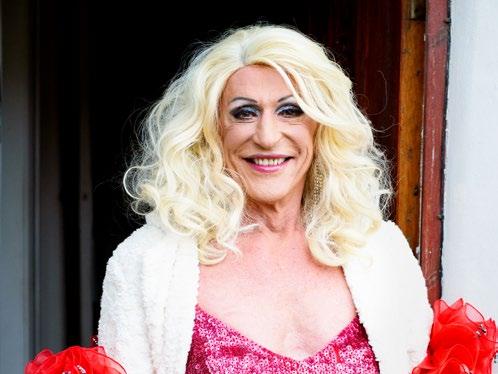
became my party piece. I would go behind the door and my brother would give me light with a torch, and often take the piss. When I finished the family would sit there and applaud. I never dressed up at that point though. It never crossed my mind. Then one day my friend from school encouraged me to go and do the talent contest at The Black Cap,” Dave recalls. The gay scene was very different in the 1970s and 80s, clandestine and often underground ensuring safety was paramount, and putting aside the obvious dangers from society more broadly, Dave remembers the fear of being a young and naive gay person and having to be constantly cautious: “I was scared. There were all types of perverts around. It was all new to me. When you’re young, you’re very impressionable. Looking back now it’s horrifying to think of some of the situations I was in. Thankfully I am able to look back.” “Everyone wanted to play the Vauxhall. I was hoping I didn’t because I was scared of falling off the bar”
“I never knew what I was when I was very young, I just knew there was something different about me because I wasn’t like the rest of my friends. When I went to The Black Cap that night I was chatted up, admired, and something clicked. It was a huge learning experience. Those days were about chatting up and foreplay. It was a lovely underground thing, not many people knew about it. Sunday nights at The Black Cap featured the crème de la crème of drag: Hinge & Bracket, The Harlequins, Disappointer Sisters to name but a few; you always had to queue to get in there. The Harlequins were mentors to me in the early days, they taught me a lot about make-up and glamour. Alistair and I were very close; we were kind of in a relationship for a bit.” Seeing Dave perform it’s apparent that he has a natural flair, something very special; it’s almost as though he was made to be a drag queen, yet it was something that he never in his wildest dreams imagined doing when he was that young boy performing to just his family. Soon after that first performance at The Black Cap, Dave found himself in the presence of the drag greats of the time. “I was starstruck many times. Especially by Mark Fleming; he was quite something to a young guy like me. Mark was an act that would go among the audience, you know the type, he really frightened people, and he also said he was best friends with the Queen Mum – that story got me at such a young age “Mrs Shufflewick was barely audible most of the time, but I was totally in awe of her; I remember one time she was lying on the floor flat-out backstage and the compère called her name; when she got up I said, ‘Do you want me to do the back of your hair?’ to which she curtly replied, ‘Oh no, no-one touches that, dear’. She then went on and did her whole set and when she came off she lay back down on the floor and fell straight back to sleep again.” Dave’s love for drag is apparent when you talk
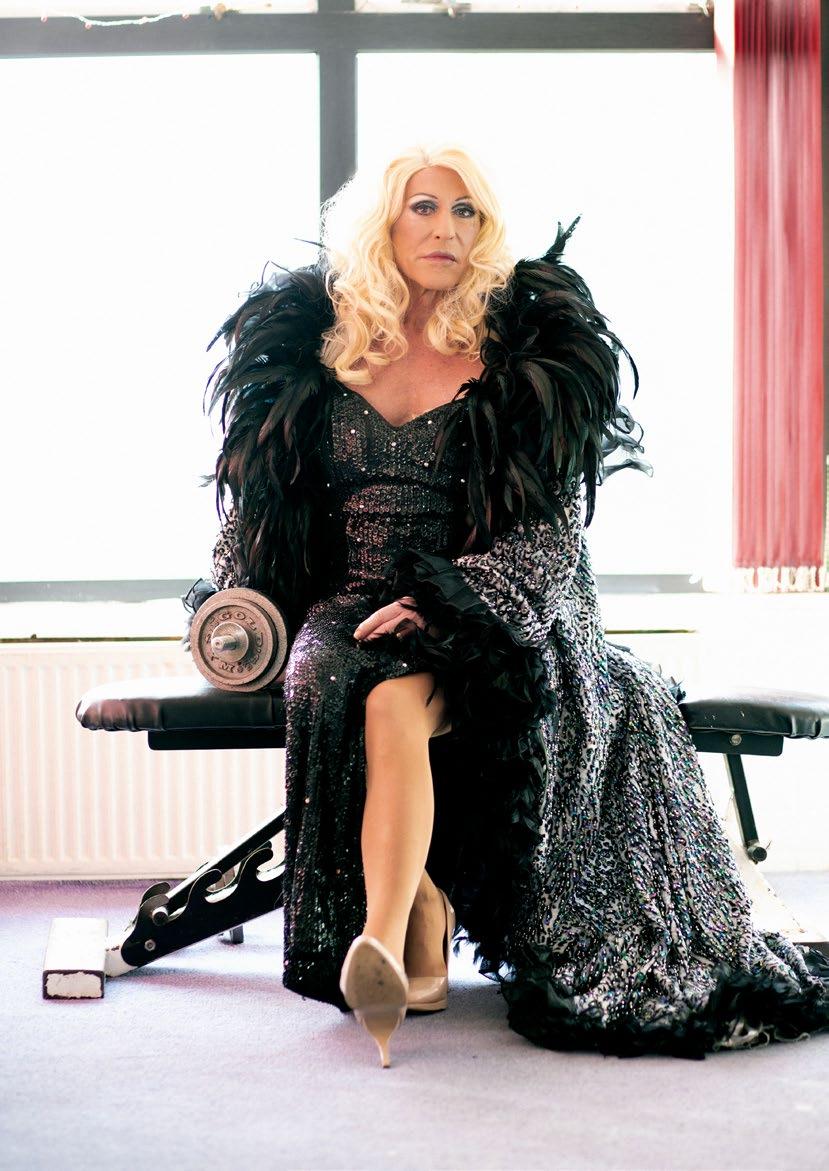
to him; that passion continues to burn deep: “Drag is a special kind of magic. What I love is the different types of characters that stick in your mind. The Trollettes were very important, and Topping & Butch, Phil Still, Nicky Young, Hinge & Bracket and Adrella. I’ve been very lucky to do all of this, and feel very grateful.” As well as playing alongside the greatest drag artists, Dave found himself playing the great venues that catered specifically to gay drag and cabaret; places that served as safe havens and creative community hubs for gay and trans people – some of which are still going strong to this very day. “When I was young and getting to know the scene, in my mind there were three royal variety venues: the Royal Vauxhall Tavern – if you got a gig at the Vauxhall it was like getting a huge thumbs up from everyone; The Black Cap, and then joining them later on, the Two Brewers. The Union Tavern was also a big deal at that time – it was almost like a little theatre. But the Vauxhall was the most famous; I remember it being on TV, and seeing Lee Paris performing on the bar. Everyone wanted to play


DAVE LYNN WITH MICHAEL TOPPING, HIS PARTNER FOR SEVEN YEARS the Vauxhall. I was hoping I didn’t because I was scared of falling off the bar. When I did eventually play there – on the stage, not the bar – it was Pat and Breda McConnon (RVT landlord and landlady at the time) who got me properly into glamour when they asked me to host a sort of Mr Gay UK contest” “I absolutely love and admire the new acts of today. I look at some younger artists and think they shouldn’t do this and that because it’s a bit dangerous, but then I was told I was dangerous years ago. If you’re not dangerous, you’re boring”
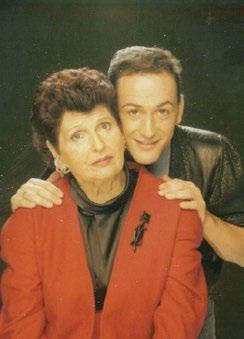
Opportunities have come Dave’s way throughout his career that were very rare in the drag world at the time, breaking through to the mainstream was not a given, only afforded to a select few drag artists of his generation and generations immediately before and after – there were no Drag Race golden tickets offering instant fame every year. Dave worked hard to be seen as a ‘serious actor’ and as such has been cast in numerous TV shows and films – most famously Beautiful Thing, Silent Witness, Coronation Street. But at what price comes fame? “A lot of painful things start happening when you get very successful; people can be very cruel. Then there was the loss of my parents. You know... people change. And I know I certainly used alcohol a lot when I was miserable. Which sometimes was, actually sometimes is, still my enemy. But I fight against that. Truly I do. Life hasn’t been that perfect. My parents didn’t want me to go into showbiz because they thought I was too sensitive. And to be honest, I thought they were right at the time. I remember years later when we were all at some do my mum said she felt so guilty for saying that because she thought it prevented me from making it, that I went in the back door – so to speak – and I told her she should never feel guilty. A comic who was present at the time said I was right to go in the back door, performing as a drag artist rather than going to drama school and the like, because that’s how you learn, and I had a niche, I wasn’t just another actor among a sea of actors all vying for the same job. It’s the best way in and you get to understand everything.” And now that Dave is, in his own words, “a grandmother of drag”, what does he think of the new British drag artists who are fearlessly taking the world by storm? “I absolutely love and admire the new acts of today. I look at some younger artists and
think they shouldn’t do this and that because it’s a bit dangerous, but then I was told I was dangerous years ago. If you’re not dangerous, you’re boring.” Being a nurturer to young artists who are finding their feet on the scene is something that’s very important to Dave, and he believes that should be standard across the board. That sense of family and belonging has long been a part of the culture of drag: “Maisie Trollette and I used to always - and still do - encourage new acts because the gay and drag scene is a community, it always has been. Some other acts hated us because we were putting on shows to try and find new talent; I even had my own drag academy. I would say to other queens: ‘Darling, if we don’t carry this on, or encourage it as an art form it will die. We need young blood’. At first some were upset because new acts were getting more bookings and they were losing out, but that’s just how life goes. It happened when I was young, and has happened to me as I’ve grown older. We should be all encouraging acts – that’s so vital. I’m thrilled that in this terrible and dark time we are living through right now I can switch on my TV and see a friend or someone I know doing what I do, showcasing drag to a huge audience. That’s incredible.” “I never knew what I was when I was very young, I just knew there was something different about me because I wasn’t like the rest of my friends.”
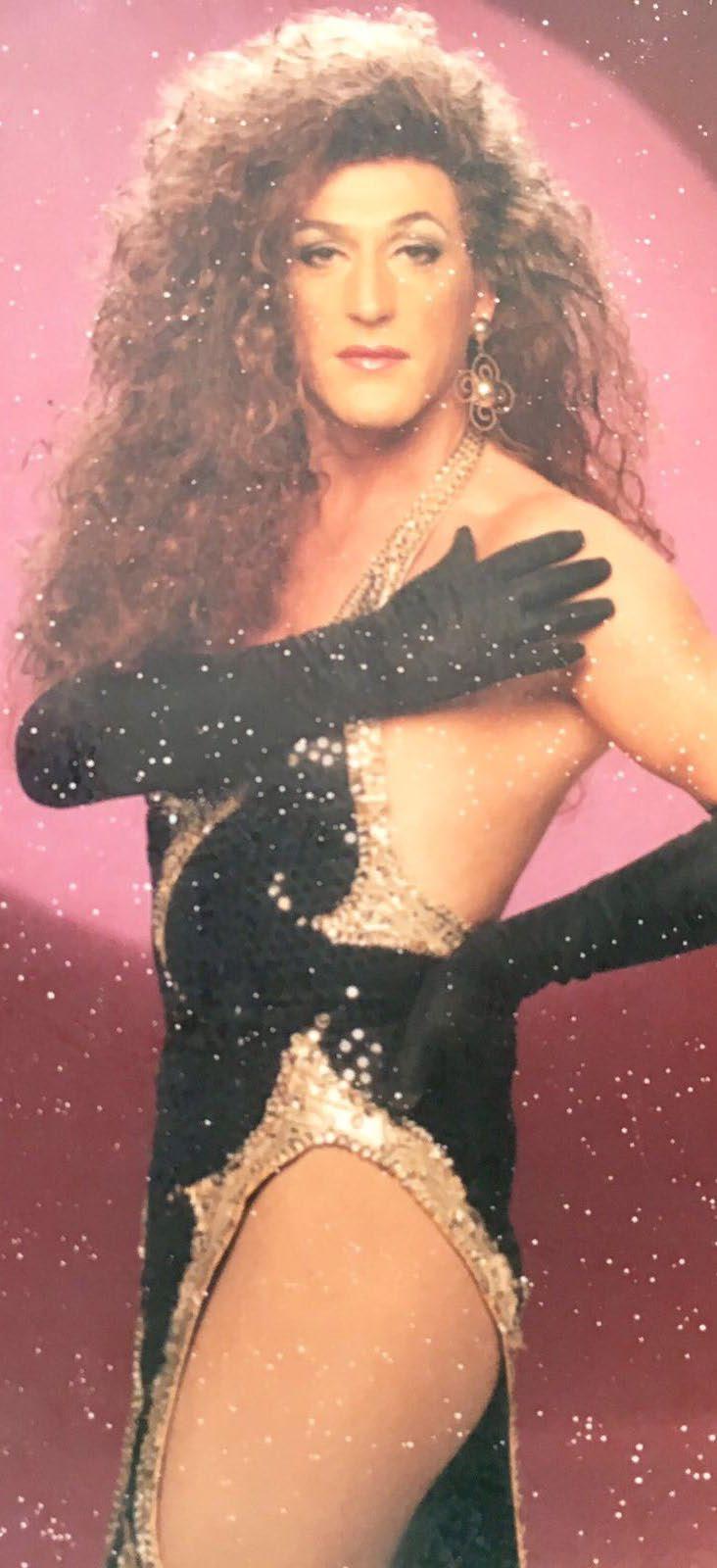
Now with the world on pause, but with glimmers of light finally shining through, what does the future hold for this giant of the drag world, where will Dave Lynn go from here? “I’ve been asking myself this a lot throughout the lockdowns. When I look back at my career I feel great. Not many people can say that. The age bit I never really understood. I often think of Maisie, who doesn’t care about age and just carries on doing what she loves. But of course not everyone is the same. I think after the pandemic it will be like a new beginning for all of us, when the venues are fully open and lockdowns are a distant memory. I would like to perhaps direct and write. I’d love to write a book. There’s a couple of things I’m currently working on, a documentary being one of them. “I’ve also been thinking more about a book that’s written from the heart – that’s very important to me, it must have real meaning. We’ve got to make things feel good. I’ve obviously got my battles; I’m old now, and there’s younger acts chomping at the bit. I will continue to work thanks to the reputation that I’ve built up over the years through hard work and determination. I can’t do the things I did 30 years ago, but I wanna see it though. Let’s just say that. I’ll continue performing beyond lockdowns and Covid-19. That’s not the way I want to stop, I’ll do it on my terms.”
Piece illustrated with photography by Tom Selmon - www.tomselmon.com
Brighton & Hove Pride 2021
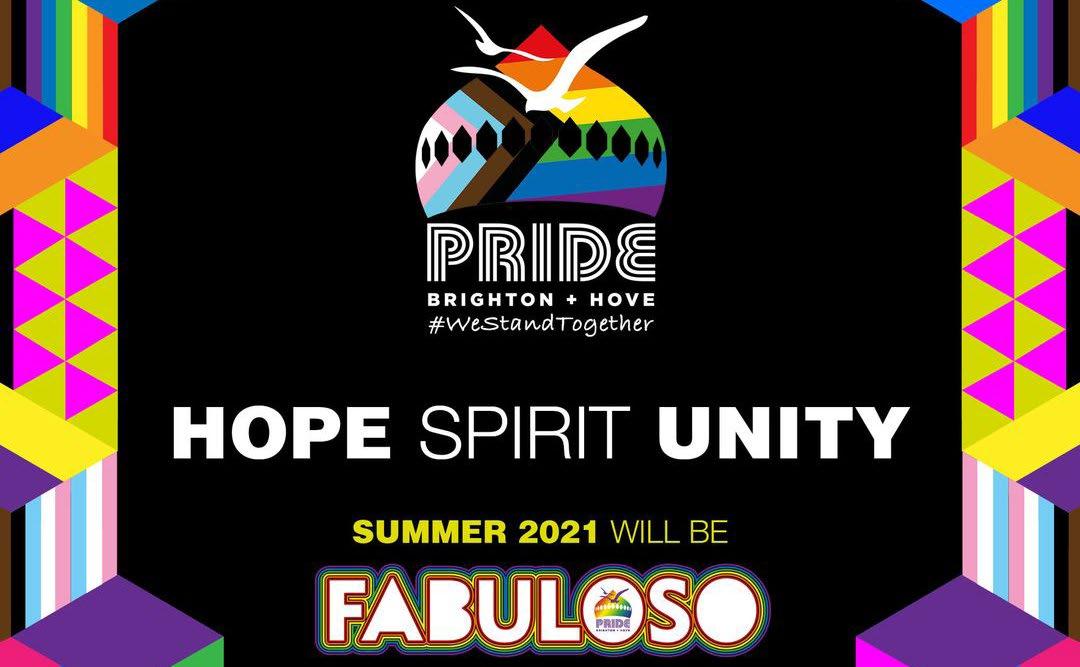
With Brighton & Hove Pride confirmed for August 6-8, 2021 the organisers respond to some questions about the event put by Scene magazine
) How is Brighton & Hove Pride different
to other Prides?
Here in Brighton & Hove we have a long history of Pride and are recognised as one of the most welcoming cities in the UK with everyone from local businesses to education hubs and residents really getting behind the celebrations to show off our fine city in the best light. What makes us different from other Prides, and special, is that we have a high-profile city centre parade route that leads directly to the festival in Preston Park with its multiple sites and entertainment stages, dance tents, cabaret venues, food stalls and so much more. Most other cities in the UK do not have the size and location of facilities to match what we can offer.
What is the future of Pride?
When we were handed the baton as the organisers of Pride, the event was in dire financial difficulty, many of the themes were somewhat frivolous and there was virtually no campaigning and very little fundraising.

BRIGHTON & HOVE PRIDE 2019. PHOTO: JAMES DALY The current pandemic has impacted hugely on charities, community groups and businesses, and importantly on their ability to deliver their services, and Pride is no different. In a normal year we would advocate for community gatherings and events so we can meet, support and celebrate our hard fought for rights, but also campaign for the rights of those marginalised communities at home and abroad who still suffer persecution on a daily basis. We are committed to fighting for the rights of all members of the LGBTQ+ family and standing with those who suffer homophobia, transphobia, biphobia and racism.
Under the seven-year tenure of Brighton Pride CIC, we are proud that the organisation has become more financially stable, with a small reserve that enables us to work on the year-round planning process. “Protest and campaigning will always be at the heart of Pride and we should never forget our roots and continue to fight for marginalised members of our community”
Pride by nature has campaigning and protest at its roots, and in the changing political environment must continue to listen and evolve. We must continue, now more than ever, to stand together as one LGBTQ+ community.
How can Pride respond to the voiced needs of the community who want a more politicised activist presence to raise legitimate concerns about the current political situation and real equality?
Pride means different things to different
people. For some, Pride is a celebration of how far we have come, for some it is a protest of issues and rights that still need fighting for and for others it is a combination of the two. Protest and campaigning will always be at the heart of Pride and we should never forget our roots and continue to fight for marginalised members of our community. We endeavour to offer a safe space at our events for the whole community to demonstrate how Pride manifests in their life, underpinned by a fundraising mechanism that ensures we can raise money for our local charities and community groups that do such essential work all year round. “We are committed to fighting for the rights of all members of the LGBTQ+ family and standing with those who suffer homophobia, transphobia, biphobia and racism”
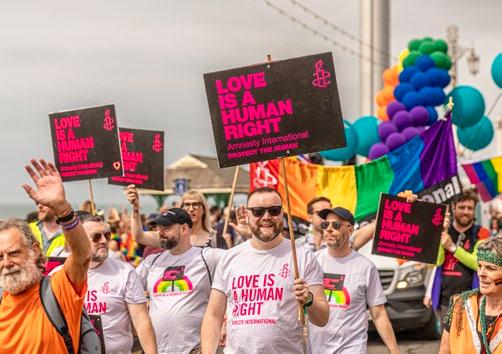
After Pride’s previous management going bankrupt in 2010, this model was agreed to ensure ongoing funding for our local LGBTQ+ charities, community groups and projects. We are immensely proud to have raised almost £1million in the past seven years that, through the Brighton Rainbow Fund and Pride Social Impact Fund, has directly supported marginalised people through the pandemic as well as throughout the year, and ensured the viability of many of our essential community groups that otherwise would not have survived during this period of austerity and funding cuts from central government.
Criticism of some Prides is that they are very corporate. How can Brighton & Hove Pride work in and with the corporate and commercial word to ensure fair treatment of LGBTQ+ people across the world is part of its ethical engagements policy?
Historically, Pride organisations have always sought to engage with local groups and businesses to help fund the delivery of events. Indeed, looking back at a Pride programme from 1995 the organisers were looking for support from businesses and ‘big companies’.
BRIGHTON & HOVE PRIDE 2019. PHOTO: JAMES DALY
Like many charities and local LGBTQ+ organisations, sponsorship has become an essential part of their annual income to help with the ongoing provision of services and certainly we’d not be able to deliver the Pride weekend and see the huge benefits to the city and our fundraising without sponsorship support. We are very mindful that all businesses we engage with must have a serious LGBTQ+ policy and messaging and actively support diversity and inclusion and their LGBTQ+ employees. This also applies to the Pride Community Parade where all entrants must adhere to a comprehensive set of standards. We are not interested in companies that just want to push their newest product on our community but we are interested in supporting companies with their LGBTQ+ campaigns and giving visibility to their employees’ networks, and over the last three years several sponsors have agreed to make direct contributions to the Brighton Rainbow Fund.
Pride has become a beautiful monster, isn’t it about time the city had a more strategic approach to this magnificent beast?
As event organisers we totally agree and at our Pride Summit in 2018 specifically put forward the suggestion that there was a citywide strategy for all large events in Brighton & Hove. While we take full responsibility for the safe running and clean-up of all our official event sites, we are not responsible for the whole city and all the visitors that come for the beach and other attractions.
Through our CityAngels initiative we already sponsor beach cleans and put in place additional resources for the cleaning of the city’s streets but there clearly needs to be a city-wide strategy for events that attract large crowds such as Pride, the Brighton Marathon and the Brighton Festival, as well as bank holiday weekends and rallies.
What advice would you have, as leader of one of the most successful Pride events in Europe, for smaller Prides just starting up?
Pride cannot be organised in isolation and “Pride by nature has campaigning and protest at its roots, and in the changing political environment must continue to listen and evolve. We must continue, now more than ever, to stand together as one LGBTQ+ community”
the most important thing we have found is the benefit of positive working relationships with local partners, local authorities, the council, transport providers and blue light services. It is vital that we listen to and engage with the community, local business and their LGBTQ+ employees while being mindful that as your Pride grows there are greater challenges and requirements put in place with cost implications for health and safety, traffic management, transport etc. Having a fundraising plan is also essential. We have found that relying of people to put money in buckets on the day raises very little for charity, in fact the Brighton Rainbow Fund calculated on the day giving at 11p per person, so having some specific ticketed fundraising events allows you to support many more local charities and community groups.
Brighton & Hove Pride to return in 2021!
Following the roadmap to end lockdown in the UK, Brighton & Hove Pride has announced its 30th anniversary celebrations will be going ahead on the weekend of August 6-8, 2021. More info/tix: www.brighton-pride.org Since 2013, Brighton & Hove Pride has raised just under £1million for LGBTQ+ causes in the city, funds which are distributed by the Brighton Rainbow Fund.
Look out for more news on Pride with a full breakdown of its Cultural Development Programme in the next issue.
Have your say on the future of Brighton & Hove Pride and WIN VIP tickets to the Pride Festival!
Pride is conducting a public survey to get feedback on what you like and don’t like about Brighton & Hove Pride to help them, and their partner agencies, plan for the future. All answers will be anonymous and strictly confidential. Brighton & Hove Pride says: “We value your views and feedbackit helps us change and improve. “We want to ensure we’re doing everything we can to achieve our vision and support LGBTQ+ people during the Festival and throughout the year.” All participants who respond to the survey by April 1 are eligible to be entered into the prize draw for VIP tickets. To complete the survey, visit:
www.brighton-pride.org/survey2021
Sussex Nightstop
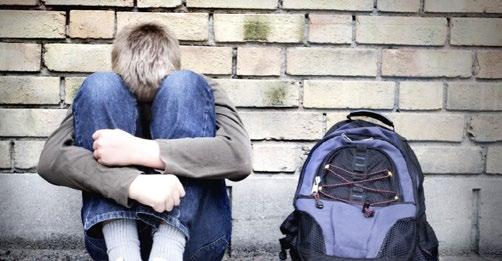
Alison Marino is executive director of Brighton-based charity Sussex Nightstop, which co-ordinates volunteer hosts who provide a safe place to stay for people who are homeless or at risk of homelessness
) Sussex Nightstop creates and coordinates a community of volunteers who provide access to a safe, non-judgemental, inclusive place to stay for people who are homeless or at risk of homelessness. Its vision is a society where everyone has access to a secure and sustainable home and the opportunity to sleep safe every night.
Who does Sussex Nightstop help?
Sussex Nightstop provides a safety-net for young people and adults aged 16 upwards in the Brighton & Hove area who may otherwise be forced to sleep rough, with all the risks that go with that, including the very real threat to physical and mental wellbeing. Somewhere safe to sleep is essential. Feeling warm and secure, having a hot meal and being treated with dignity provides people with the rest, energy and confidence with which to access the resources and support necessary to find a safe, longer-term home. Our volunteer hosts provide that. By opening up their spare room for short stays, people can sleep well, share a family meal, access crucial amenities, including somewhere private to wash and, above all, experience kindness in an otherwise bleak situation.
The majority of Nightstop guests have either suffered a family or relationship breakdown or breakdown of their tenancy, often brought about by a number of combining pressures, such as financial strain, the challenge of living with poor mental health and a local private rental market increasingly beyond affordability. We also know that some people are more vulnerable than others; worryingly 24% of young homeless people identify as LGBTQ+ with 77% believing that coming out to their parents was the main factor. At Nightstop we also know that guests are individuals – both interesting and interested in life, often working or studying, who have aspirations and plans and who just need a secure place from which to navigate this difficult time in their life.
What difference has Covid-19 made?
Covid-19 has brought even more anxiety for those facing or experiencing homelessness. Many families and individuals have faced challenging lockdown circumstances and the end of the furlough scheme and the prospect of a recession on the horizon will only precipitate the issues that place people at risk of homelessness.
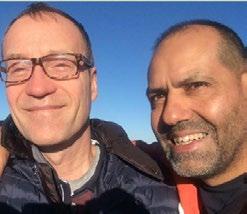
Never has a community response been so needed and ensuring we have a pool of volunteer hosts ready and waiting is a top priority. That is why we are currently looking for new host households. If you think you could help someone experiencing homelessness through short stays (roughly four to seven nights) then we’d love to hear from you.
David and his partner, Mark, have been hosting with Sussex Nightstop since 2014. David says: “Me and my husband had been looking for a volunteering opportunity for some time when we came across Sussex Nightstop. Our first thought was that it was a brilliant idea, but also a little bit scary. Some of the most rewarding things in life are though, so we decided to give it a shot. “Hosting the 40 or so young people we have taken in so far has been the most rewarding thing we’ve ever done, and has actually brought us together as a couple. I’ve often
DAVID & MARK been proud of my husband as I’ve watched him listening to a young person’s story, and just being the supportive and caring guy that he is. “At the start of our journey with Nightstop we wondered how young people would react to being placed with a gay couple, but we quickly learned this wasn’t an issue at all. Young people today just don’t care so much about those things; we’ve just been seen as any other family they may have stayed with, and they’ve all been just as accepting of us as we are of them. And when we’ve had gay or trans young people to stay, it’s taken on an even greater meaning for us, as we’ve been able to do something meaningful for our own community. “None of this would be possible without the confidence gained through the training Nightstop provides, as well as the support provided when hosting. Advice is always just a phone call away, so you never feel you’re on your own. “The biggest difference is giving me somewhere safe to be. Not needing to stress and worry about where you are going to sleep that night” – Sussex Nightstop guest
“I’d really encourage anyone with the time and space to get involved with Nightstop hosting to give it a go. It really is the most wonderful feeling knowing a young person is safe, wellfed and refreshed because of you and that you’re a part of them finding somewhere to call home. Plus, you get to meet some nice, smart, funny, interesting people along the way.” Get involved
We’re inviting ALL members of our caring and diverse community – all genders, faiths, ethnicities and sexual identities – with a spare room to join our community response to homelessness.
If you think the rewarding role of volunteer host is for you then get in touch:
www.sussexnightstop.org.uk/contact-us/
Full training, support (including 24-hour oncall service) and nightly hosting expenses are made available to all of our host volunteers. D www.sussexnightstop.org.uk t @SussexNightstop f Sussex Nightstop To make a donation, visit: https://localgiving.
org/charity/sussexnightstop/
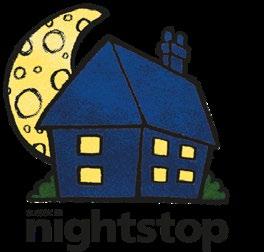
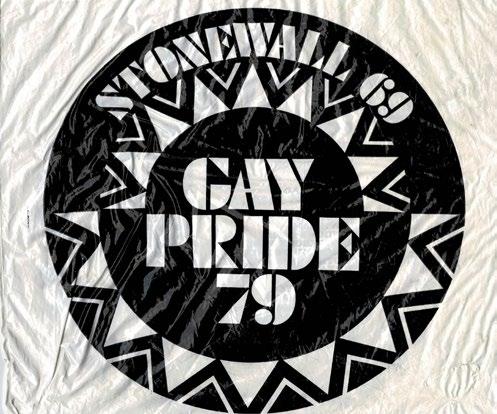
ROSE'S STILL-INTACT SOUVENIR BAG FROM GAY PRIDE 1979
The Boy and The Bear
As part of her ongoing Arts Council England-funded Forty Years Out (And Counting): Performing The Archive multi-media project, The Boy and The Bear was written, performed, recorded, edited, arranged and produced by Seaford-based performer and writer Rose Collis during the 2020-21 lockdown
) The Boy and The Bear was inspired by, and draws on, sections of the research and script development of her new solo stage show (postponed until 2022) — a scripted and performed audio-visual account of the rich personal and political journey taken by Rose Collis and her then closest gay male friend, who both came out in 1978.
The personal stories unwind against a social and political backdrop and context of early Gay Pride marches; police harassment; anti-fascist/ anti-racist activism; ‘agit-prop’ gay and feminist theatre; the London lesbian and gay scene and media of the late 1970s and early ’80s; and the first decade of the AIDS crisis — all viewed through the lens of a veteran lesbian writer, performer and activist who participated in, witnessed and chronicled these events.
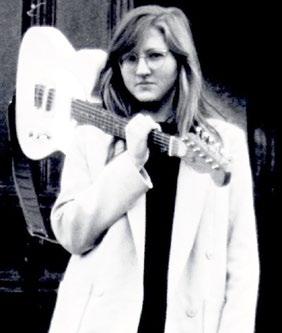
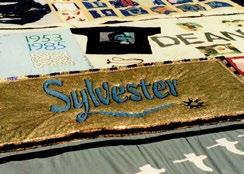
ROSE COLLIS AGED 19 IN 1979 Funny, provocative and moving, the film includes personal testimony, letters, photographs, diaries, ephemera, news cuttings and others materials from the extensive archive of Rose Collis curated over five decades, plus some of her original music.
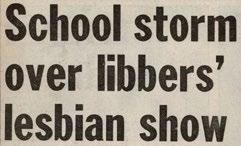
DAILY MAIL HEADLINE
“It’s rather funny how this film came about,” Rose Collis wryly reflects. “Once lockdown came and I had to postpone the stage show, I had to think about delivering different project outcomes. Arts Council England was very flexible about re-purposing my Project Grant to buy relevant equipment. “So – for less than £500 in total – I bought a complete podcast/audio recording equipment kit; a Canon professional quality digital video camera kit; a digital projector, stand and tripod project screen, and downloaded the free Windows Movie Maker video software and Audacity professional audio recording software. “I immediately saw the potential of simple audio-visual digital pieces and originally envisaged doing a series of five-minute, ‘straight-to-PC-camera’ vlogs. But then I realised just as quickly how boring that would be for audiences – and for me. I mean, that sort of piece is all well and good, but I think after several months of watching people do that, I figured that audiences might want something a little more interesting to watch or listen to, and I certainly wanted to work on something more challenging. “After that, it took on a life of its own – and this film is the result. It’s been really exciting to teach myself how to use all this fabulous equipment and software, especially as it presents me with new opportunities to take work to global public audiences, now and in the future.
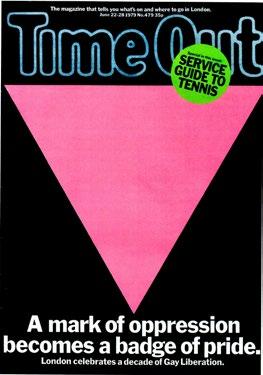
“And I did it all here from my desk at home in Seaford. What’s not to like?
“I hope what I’ve done inspires other older women artists to be confident about embracing digital equipment and technology to create their work, and tell more women’s stories. We are 51.9% of the population – the majority, treated like a minority, and our histories are so often overlooked, hidden or forgotten. “And I’m already planning my next film project – so watch this space.” D To see The Boy and The Bear, visit: https://
youtu.be/g3pNXvMSlRM
D www.rosecollis.com
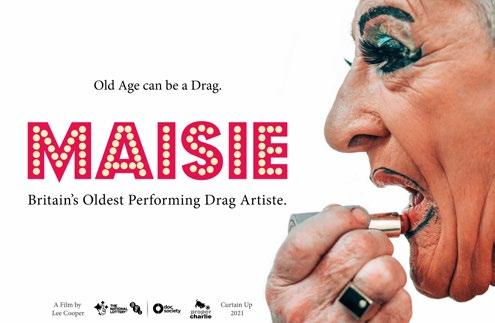
The Doyenne of Drag
Lee Cooper, of Proper Charlie Productions, made “an intimate portrait of ageing and friendship”, following the life of David Raven, the performer behind Maisie Trollette, in the run-up to their 85th birthday. Lee talks to Jaq Bayles about the project
) Britain’s oldest performing drag artiste and scene treasure Maisie Trollette, aka David Raven, is the subject of a new documentary by Brighton film-maker Lee Cooper, who set out to make a piece of work that addresses the twin concepts of ageing in the LGBTQ+ community and the “dying art” of panto-style drag. Lee describes his 75-minute “passion project” as: “An intimate portrait of ageing and friendship in the LGBTQ+ community. Viewers can follow David as he counts down to his 85th birthday [in 2018] and all the celebrations on the way. “It’s very much about exploring ageing in the community and it’s a warts-and-all look at that. In some of the backstage footage he was generous enough to let us see everything when the curtain falls. David can be challenging at times and it was an eye-opener, but it’s quite touching in the way he was so open to exposing himself and the frailties of old age. “There are many amazing coming out stories on film, but what about the other end of our experiences? It’s just not sexy – trying to raise money to help make the film was difficult. A lot of younger people in the community think drag is RuPaul and that very British, endof-the-pier, panto-style of drag faces being replaced by pageant queens – which I do think are brilliant – so it’s a dying art form.” In order to complete the documentary Lee and his cameraman, Sam Parsons, and sound expert Shane Gravestock, spent three years “on and off” following the cabaret legend around.
Lee picks up the tale from the beginning. “I am relatively new to film-making, my background is in fashion art direction. But I went to film school and as part of the course we were tasked with creating a documentary.
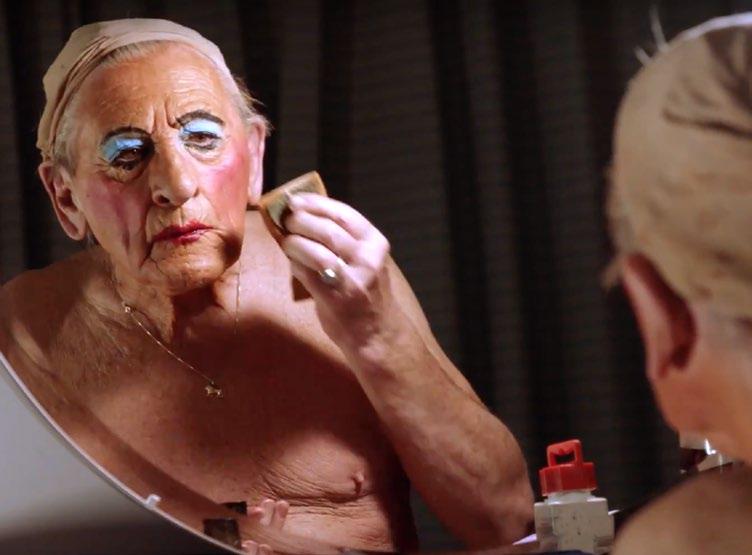
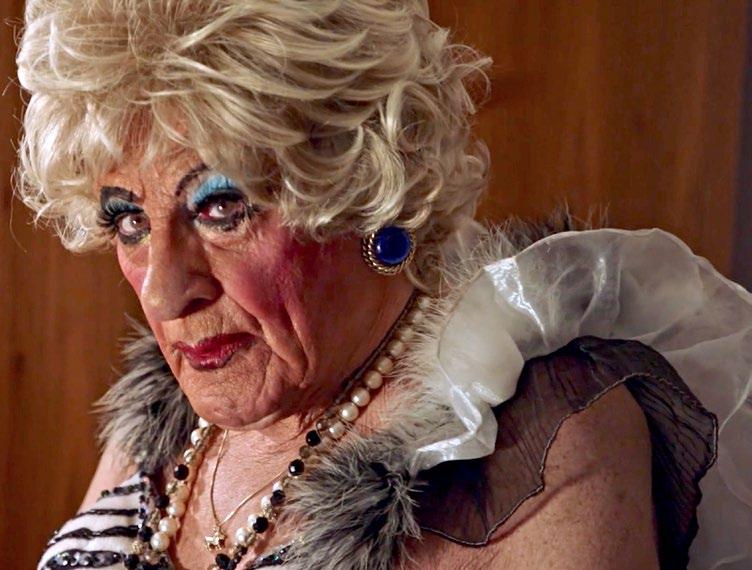
“I’m a huge fan of the cabaret scene in Brighton and have lived here for 15 years. I love all the performers and somebody gave me an introduction to David, saying he was lovely, colourful, and he let me into his life. I just sort of fell in love with him.
“He’s such a character and has led such a colourful life. He was really generous about letting me into his life. “When I finished the course I did a complete left turn and made a horror film in Spain. At the premier a director, who is known, came up and said she enjoyed the film but where was the documentary about Maisie? She reignited that interest in me and I realised it had been a scratch I had not quite itched.” At that point Lee only had around four minutes of footage, exclusively put together for his course work, so filming then began in earnest and the ensuing research unearthed an unexpected bonus. “We knew David was the oldest performing drag artiste in Britain, but we wondered if there was anyone older doing the same thing elsewhere in the world.”
Guinness World Records put Lee on the trail of Walter Cole, aka Darcelle XV, who “comes from a long line of drag queens”, lives in Portland, Oregon, and is two years older than David. would love to have his involvement in the film and would he record something for David’s birthday? He told us he was going to be in London the next month, had never been to Brighton and would love to come here. The stars aligned.” The two artists did a performance together at Legends, but “before they met as their female alter egos they met as men for afternoon tea,” says Lee. “It was the big meeting of the US Pageant Queen with Britain’s Panto Dame.” While exploring the ageing theme, the documentary doesn’t skimp on the fun stuff either, featuring other well-known cabaret names such as Miss Jason and Dave Lynn, “really exploring how the cabaret community supports and look after David”. Then, of course, there are the songs. Luckily, the BFI Doc Society came on board and helped to pay for the usage of the songs, permission to use them in film not coming cheap. “This means we will be able to distribute the documentary worldwide and everyone will be able to enjoy it. As well as watching behind the scenes they can enjoy the scenes in the cabaret.”

Among old favourites that feature are The Lady is a Tramp and the “big finish is one everyone knows and loves him for, If I Never Sing Another Song”, while viewers will catch in the background the likes of Sonia, The Three Degrees and Rozalla. Lee is currently seeking distribution and hopes the documentary will be released in the summer.
But the work doesn’t stop there. “We are talking to a number of charities, including the Brighton Rainbow Fund, and are planning on releasing a charity single of The Trollettes singing Two To One, which was written for them.
“When we get confirmation of a release date for the film we will release that and hopefully release the soundtrack to the film.” D For more information, visit:










